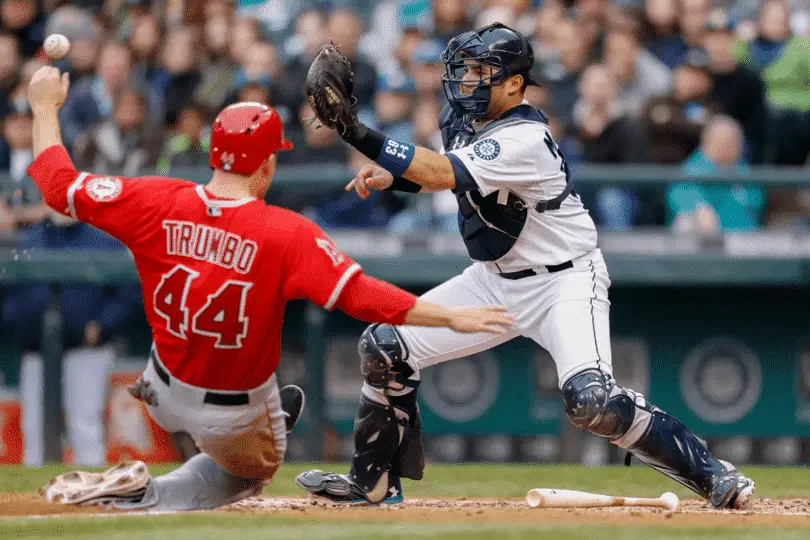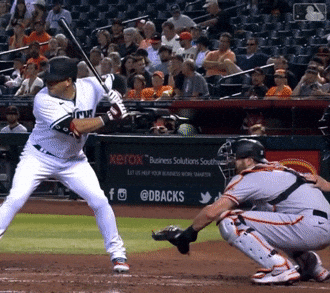
What is a Catcher's Balk?
A catcher's balk is an informal phrase used to describe a catcher doing something in violation of two specific rules which results in a penalty by the umpire.
If runners are on base, then that penalty is a balk - meaning, the advancement of each runner by one base. If no runners are on base, then the penalty is a ball.
We provide more detail on what constitutes a catcher's balk in the following sections of this article.
Two Types of Catcher's Balks
A catcher can cause a balk, but a balk is always attributed to the pitcher in the scorebook.
Per the MLB rulebook, there are two scenarios that fit in the category of a catcher's balk. Let's look at each.
1. Obstruction When a Runner Attempts to Steal from Third
Rulebook Reference: Rule 6.01(g)
The first category can occur only when there is a runner on third and that runner attempts to steal or run home on a squeeze play.
If the catcher does not have the ball but gets up and stands in front of home plate, then the play stops and the runners advance.
Additionally, if the catcher happens to touch the batter or his bat in this scenario, the same penalty applies. The play stops, the runners advance, and the pitcher is charged with a balk.
Here is an example of this occurring at an NCAA game between Nicholls State and Sam Houston State.
In the video you can see the runner at third attempting to steal home. The Sam Houston State catcher recognizes this early and jumps out of the box in front of home plate before the pitch is delivered. The umpire correctly called a catcher's balk on this play.
2. Leaving the Catcher's Box Early
Rulebook Reference: Rule 5.02(a)
In this scenario, a team is penalized if the catcher moves out of the catcher's box prior to a pitch being thrown. This has been enforced when a batter is being intentionally walked and the catcher leaves the catcher's box early, as described above.
If runners are on, then the pitcher is charged with a balk and the runners move up one base. The penalty is an illegal pitch, or a ball, if no runners are on base.
The video below shows a real world example of this occurring.
Is It a Catcher's Balk When a Catcher Stops a Ball with his Mask?
During a game against the San Francisco Giants and Arizona Diamondbacks in August 2021, Giants catcher Curt Casali used his mask to stop the ball. The umpire paused the game and moved the runners up.
Many in the media referred to it as a catcher's balk, and this fairly rare call suddenly got a lot of attention in the press and online.

Technically, Casali's miscue was not a catcher's balk but catcher's interference that was charged as an error (E2). It's understandable though why people think it was a balk since the runners moved up, just like they would due to a balk.
This actual scenario can be found in section 5.06(b)(3)(e) of MLB's rulebook. The exact description in the rulebook says:
"A fielder deliberately touches a pitched ball with his cap, mask or any part of his uniform detached from its proper place on his person. The ball is in play, and the award is made from the position of the runner at the time the ball was touched" (source).
Instances of This in the MLB
Pro catchers using their masks to stop a rolling ball, typically after blocking a pitch, is rare but it does occur. Using a variety of sources, we could find a few instances of this happening in the last 30 years, as detailed below.
- 2021, Cleveland Indians catcher Ryan Lavarnway.
- 2021, San Francisco Giants catcher Curt Casali.
- 2018, Boston Red Sox catcher Christian Vazquez.
- 2013, Baltimore Orioles catcher Luis Exposito (note: it occurred during a spring training game).
- 2010, Seattle Mariners catcher Adam Moore.
- 1995, Pittsburgh Pirates catcher Angelo Encarnacion.
Why Does it Matter if a Catcher Uses his Mask to Stop the Ball?
It matters because it's against the rules! And if it's against the rules, the umpire will call it against you.
The real question then, is why is it even in the rulebook? Using your mask to stop a ball seems harmless enough.
We think it's in the rulebook to prevent a fielder (in this case, a catcher) from using his gear to throw it at a ball to try and stop it.
Anyone who regularly played baseball as a kid can probably remember throwing their glove or hat in frustration at a ball that got past them. At least I do.
So, if this is indeed the logic behind the rule, then we suppose it makes sense.
What's the Difference Between a Catcher's Balk and Catcher's Interference?
A balk is an illegal action in baseball attributed to a pitcher. There are two specific scenarios when a catcher takes an illegal action that results in a balk charged to the pitcher, which we describe above.
Catcher's interference, on the other hand, occurs when the catcher makes contact with the batter or the bat while the pitcher is pitching.
It is also called when the catcher uses his mask to stop the ball, as we describe above, or in other cases where the umpire determines that the catcher was actively trying to hinder a batter from hitting.
Catcher's interference calls are infrequent, but generally much more common than a catcher's balk call.
Thanks for Reading!
We hope that you found this article to be useful. If you have questions or comments, please send us a message by going to our contact page or by emailing scott (at) catchershome (dot) com.
Thank you for stopping by Catchers Home.
Sources for This Article:
- Major League Baseball Rulebook
- Umpire Bible
- NBC Sports
- Kansas City Star
- Baltimore Sun
- Baseball Reference
Scott Perry
Scott Perry is the owner and lead author at Catchers Home. He's a former baseball player, a current coach, a husband and a Dad. He remains as passionate about baseball today as he was as a kid.

